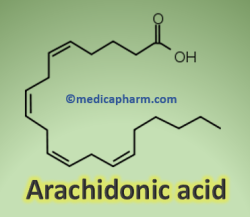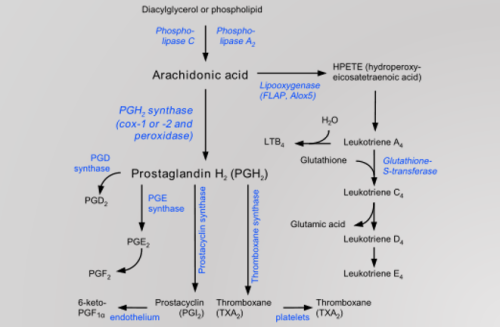PGs, or prostaglandins are inflammatory mediators. Prostaglandins which are a sort of eicosanoids substances are deeply involved in this subject. We will get to know about them closely in the upcoming paragraphs.
Have you ever wondered what inflammation is or where does it come from?! Naturally, the human body has its own ways of defense which permit and ensure self protection. It’s capable of defending itself against plenty of external dangers and overcome them. Dangers include, but are not limited to, bacteria, fungi, viruses, and protozoa.
The immune system is mandated to do the main physiological function of defense. That system does so via its troops of the white blood cells. Fundamentally, there are many types of white blood cells as the neutrophils, monocytes, and others. Each type of the WBCs has its very specific role that differs from those of other WBCs types.
The battle begins between the troops of immune system and the invaders and finally it’s over. Basically, before that whole thing, there are missing scenes. The scenes that made the situation escalated to immune defense in such a way. Let’s have a flashback about and throughout what happened immediately before these very moments.
■ Paracetamol, Acetaminophen, or the medication known as Tylenol in U.S.
■ Ibuprofen, the painkiller NSAID, its uses and side effects
■ Diclofenac: one of the powerful NSAIDs commonly used
When you get infected by invaders such as bacteria, the stimuli of your body notice this. Those stimuli are the same exactly as a group of organized vigilantes. According to the stimuli responses, a defense mechanism is triggered. This mechanism starts by releasing substances known as eicosanoids. Prostaglandins, prostacyclins, leukotrienes, and thromboxanes are collectively known as eicosanoids.
Eicosanoids are considered as a type of autacoids which are local hormones. They are biological factors with a brief duration and exert specific actions near their release site. Eicosanoids are signaling molecules which have various roles in
- Inflammation, fever, regulation of blood pressure, and blood clotting
- Immune system modulation and control of reproductive processes
- Regulation of the sleep and wake cycle and tissue growth
Prostaglandins biosynthesis
The mechanism just mentioned starts by utilizing the phospholipid that exist in body cell membrane. Through phospholipase A2 enzyme, phospholipid/diacyl glycerol is converted into an acid called arachidonic acid. This acid then proceeds via specific metabolic pathways to give prostaglandins, leukotrienes, and thromboxanes. As showing in the figure, this is a 20 carbons chain acid with polyunsaturation.
P.S. Saturated carbon chain has only single bonds.
It can be naturally found in some foods or synthesized. Arachidonic acid is necessary for nutrition in the body, but too much can be extremely harmful.
Arachidonic acid aids a lot in skeletal muscle growth. It’s enlisted under the PUFAs (Poly Unsaturated Fatty Acids). The PUFAs are essential fatty acids.
Prostaglandins Role
Prostaglandins have various significant functions. They mediate pathogenic mechanisms, including the inflammatory response. Prostaglandins elicit inflammation, fever, and pain. Also, they protect the stomach lining from destroying effects of gastric acid. In addition, they support the blood clotting function of platelets.
Prostaglandins are lipid autacoids derived from arachidonic acid. They are produced within cells by an enzyme called cyclo-oxygenase (abbreviated as: COX). They are released to outside cells by a very specific transporter. COX enzymes 1 and 2 are known together as PGH2 synthase enzyme.
The two most known forms of that enzyme are COX 1 and COX 2. Both of them produce prostaglandins that promote inflammation, pain, and fever. However, only COX 1 produces prostaglandins that support platelets and protect the stomach.
Prostaglandins can promote or diminish the inflammation. Controversially, both effects are not exactly known which one predominates. PGs coming from the metabolism of COX 1 decrease inflammation. However, those coming from the metabolic pathway of COX 2 promote inflammation. To sum up this point, PGs of COX 1 are good, whereas those of COX 2 are the bad ones.
Inhibiting the COX isoenzymes (different forms) will prevent formation of PGs. While inhibiting the LOX (lipooxygenase) enzyme will cease the synthesis of leukotrienes. It worth to mention that prostaglandins and thromboxanes A2 are collectively known as prostacyclins.
I hope this article is fruitful and very informative to you. If so, please do share it among your friends


